Corsair Obsidian 350D Case Review
by Dustin Sklavos on April 25, 2013 11:00 AM EST- Posted in
- Cases/Cooling/PSUs
- Corsair
- MicroATX
Noise and Thermal Testing
If the noise and thermal testing bordered on being academic for the Fractal Design Define Mini, it's even more out of place with the Corsair Obsidian 350D. The Define Mini lends itself well to liquid cooling, but the 350D was outright designed for it, and that substantially reduces the importance of air cooling performance. As a result, our conventional testing isn't just beneath the 350D's pay grade, it's not even at the same place of business.
With all that said, though, there are still a few things to learn here. Remember that the 350D starts at $99, making it an affordable enough starting point for the end user who just wants a classy, easy-to-build chassis.
Ambient temperature during testing was around 22C.
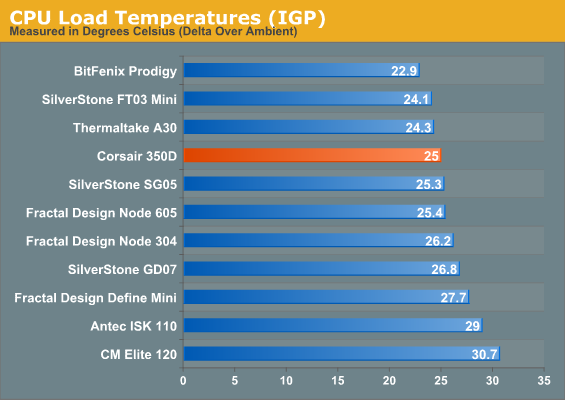

Thermally the Obsidian 350D puts in a fairly healthy performance. Competitive without being spectacular, it mostly suffers from being an offshoot of the basic ATX case design. Air cooling thermals have never been Corsair's strong suit, but they've always been workable, and the 350D continues that trend.


Because the 350D is able to keep thermals reasonably low, noise stays low as well. The vanilla testbed is nowhere near stressful enough to really work the 350D.
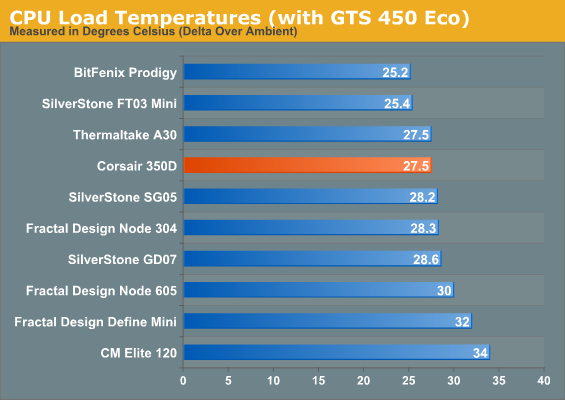
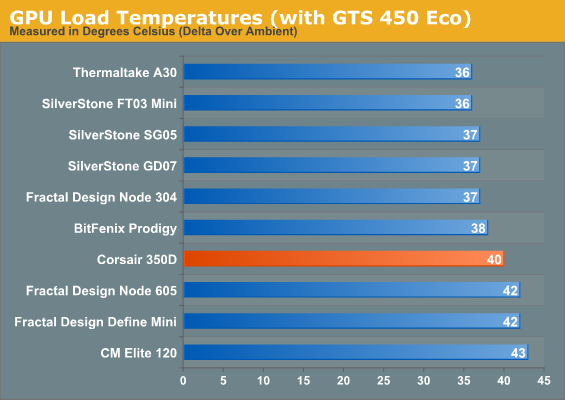
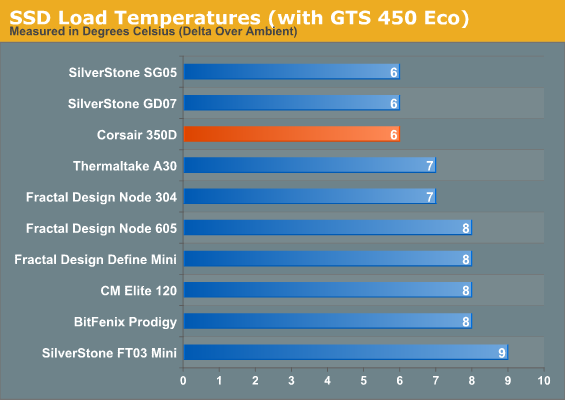
When you add even a modest dedicated graphics card, Corsair starts playing that old familiar song. The plastic "cage" used for the SSD doesn't seem to be particularly detrimental to its temperatures, but even the direct airflow from the front fan onto the GTS 450 Eco isn't really adequate. CPU thermals remain solid, though.
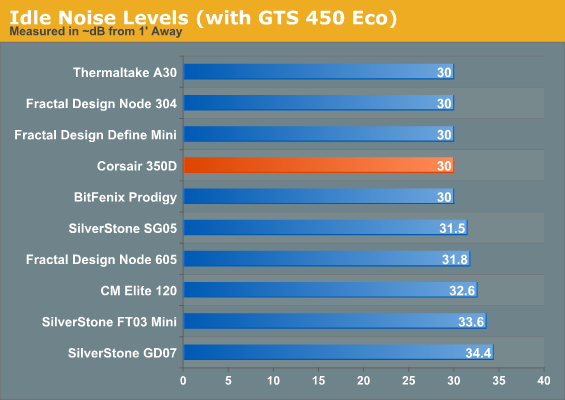
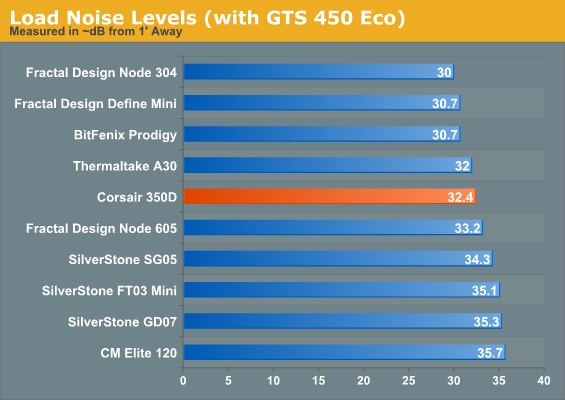
Idle noise continues to be a non-issue. Load noise isn't terrible, but it's not very impressive, either. While Fractal Design's case has a lot of acoustic padding and is built with heavy steel to help insulate noise, the 350D has no such allowances, and noise becomes entirely dependent on the efficiency of the cooling system.
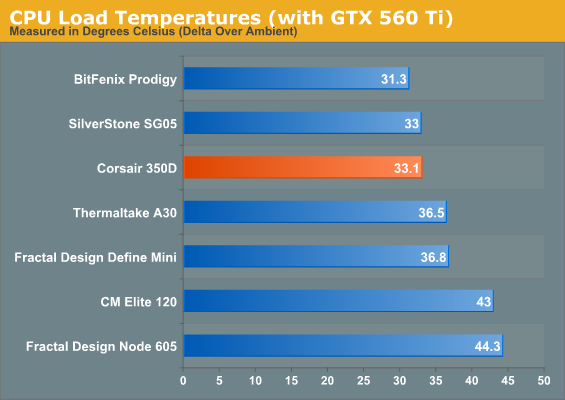
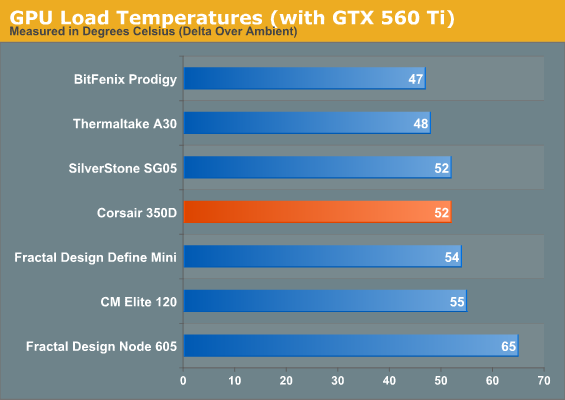
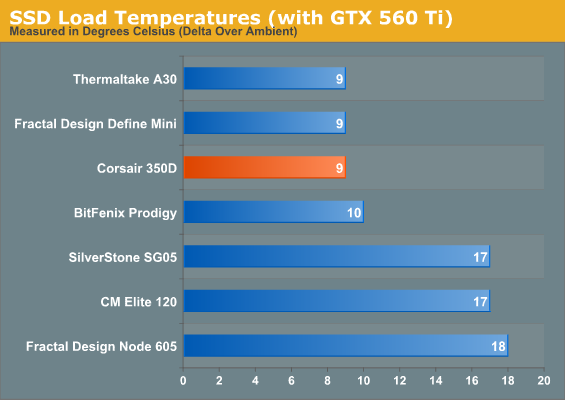
Adding a more robust video card only reinforces what we've already learned. CPU cooling performance is above average, but GPU cooling performance continues to be middling. These cards are using open air coolers that will tax the case's cooling system, and the middling stock cooling (one 140mm intake and one 120mm exhaust in their typical ATX locations) doesn't do the 350D any favors.
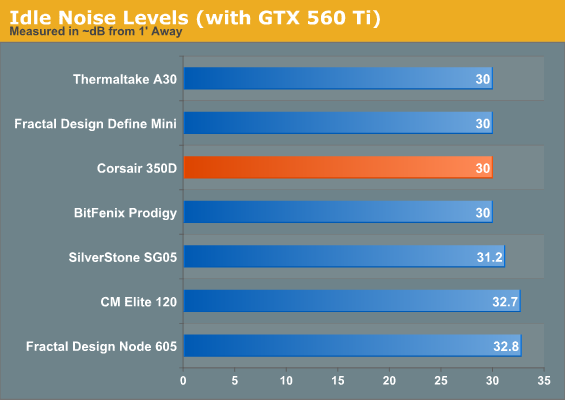

Noise levels are reasonable. The cooler on our GTX 560 Ti can be pretty rough on any enclosure (and is outright hostile when the 560 is overclocked), but at least the 350D isn't getting overwhelmed.










65 Comments
View All Comments
ghm3 - Thursday, April 25, 2013 - link
I do, I got a 5.25" drive cage to stuff 6 SSDs into my Silverstone TJ08-E.CrimsonFury - Thursday, May 9, 2013 - link
There are a few options if you are after a smaller mATX tower.Lian-Li do a very small matx tower. 1x optical bay, 7x HDD bays PSU is mounted over the motherboard (does limit tower heatsinks, but fits many mid sized heatsinks)
The Silverstone TJ 08-E is another option, it does still have 2x optical bays, but it mounts the PSU up top instead of leaving radiator space, so its quite a bit shorter in height and depth than than the Corsair 350D. Has a 180mm intake and 120mm exhaust (they also do a variant with 2x120mm intake, but I forget the the model name). Still has room for 1x radiator up front is you sacrifice some of the HDD bays.
Gunbuster - Thursday, April 25, 2013 - link
Does it come with a phantom tea cup like in the main photo?just4U - Thursday, April 25, 2013 - link
Did you guys notice? Even Dustin's wiring looked a little better. Damn Corsair is GOOD! (lol im kidding Dustin GREAT REVIEW!) I think your Bronze award was a little conservative, did you do that because you thought you might have gotten a little biased?Rolphus - Thursday, April 25, 2013 - link
This looks like a lovely case, but I'd have preferred to see it hit with a lot more thermal load in testing. I have a Silverstone TJ-08 with an i5-2500K (at 4GHz), and 2 GTX 580s in SLI. The case (just about) keeps up with that level of load, but I'd be interested in how well the Corsair does with something similar.scook9 - Thursday, April 25, 2013 - link
Great review! I have been very excited to see more about this case since the 900D came out. What you really need to do is compare this to the Antec Mini P180. I know it is discontinued but it was easily THE mATX case to build a system in back in its day (my server is still in mine as I grew to full ATX and a 700D). I do not even have a need for this case but want to just get one because hahamkygod - Thursday, April 25, 2013 - link
This is what is considered a Micro ATX case now? Good lord. It's actually a bit taller and wider than my Antec P150 full ATX case. Is the size increase the price you pay for having a case that supports water cooling? If that's the case, I want to see Corsair make some cases that aren't designed with watercooling in mind.antef - Thursday, April 25, 2013 - link
As I mentioned in the Fractal Design Define Mini review, I completely agree that cases like this should barely be considered "micro"-anything. They could be a lot smaller, and I feel like manufacturers are just afraid to because they think people want bigger everything. Then why even make a MicroATX case? Check out the SilverStone Precision PS07, it's only 14.7" tall, 15.75" deep, and 11.46 lbs. Can hold any size video card, 2 drives without the cage, a ton more with the cage, and plenty of spots for 120mm fans. I don't know why they need to make them any bigger.Jumpman23 - Thursday, April 25, 2013 - link
Does the optical bay include a face plate? It breaks the smoothness of the front view without a face plate to sit flush with the front cover.MadMan007 - Thursday, April 25, 2013 - link
I like this case, the layout and design decisions seem well-thought out and the front is attractive. It still includes 2 5.25" bays for those of us who use optical drives, for those who don't they allow for a radiator or 3.5" drives.The one shortcoming imo is the limited number of 3.5" bays. The 2.5" bay stack is a neat feature, but since it's completely removable using that space for 3.5" bays (which can obviously hold 2.5" drives as well) would give more options. It would make things very tight near the frint edge of a mATX board but it would still fit. With the low idle power draw of modern systems, using a main PC as file storage and serving makes more sense than it used to. If Corsair came out with an optional 3.5" rack to go where those 2.5" bays are the case would be even more flexible - add one, get 2 more 3.5" bays without blocking the intake fan, add 2 (for 4 drives) for maximum storage.